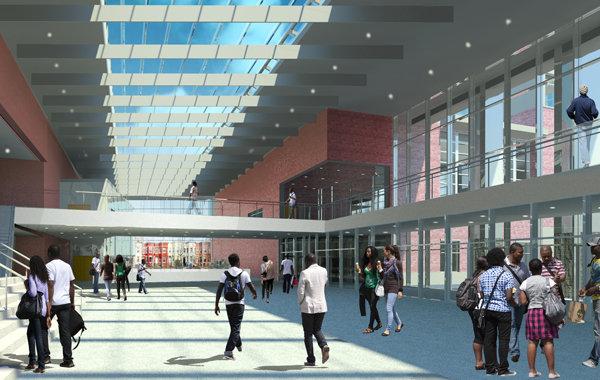WASHINGTON—When Nadine Mathews King first walked among her peers in long black skirts, and crisply pressed, starched white cotton blouses at Paul Laurence Dunbar Senior High School in the 1950s, she did not know the history of the school.
It was the first high school for African Americans in the United States, established with one teacher and 15 students in a church basement in Washington, D.C. in 1870. It was then called the Preparatory School for Colored Youth. Since it was founded, the school has had multiple campuses.
The latest campus is a $122 million LEED Platinum high school, and will open its doors to students at the end of August. To kick off a week long celebration of the new campus and the Dunbar High School legacy, District of Columbia Mayor Vincent Gray, alumna and D.C. Congresswoman Eleanor Holmes Norton, Kaya Henderson, chancellor of the D.C. public schools, and other leaders and alumni gathered on Aug. 19 at Dunbar High School in Washington.
“Dunbar has always honored its past, but has never lived in the past. Dunbar finally has a facility worthy of its history. I have no doubt that this magnificent campus will inspire students and teachers alike to cherish its tradition … Today we can tell Dunbar students to cherish our history, not to worship it … Dunbar has always used its history to make more history,” said Norton.
Norton and King were classmates. As King sat in the school auditorium where Norton spoke, she realized that four of her classmates being honored with living legends awards. Annice Wagner, chief judge of the District of Columbia Court of Appeals was one of them. Wagner graduated from Dunbar in 1955. Dr. Harold Freeman, founder of the Harold P. Freeman Patient Navigation Institute and former President of the American Cancer Society was also recognized as a living legend.
Dunbar has eight graduates featured on U.S. postage stamps, said Gray.
The legacy of academic excellence at Dunbar High School was at its peak prior to desegregation in 1954, according to Ronald Crockett of the Dunbar Alumni Association. The school was known for its professional faculty. Many of them were former professors at top universities. Because of its faculty and reputation for sending students to college, serious students from Washington, D.C. and other areas traveled to attend the school.
“I had all As and one B and could not make the honor society,” said King.
With the new campus, Dunbar aims to regain its tradition of academic excellence with three new academies, according to Crockett: the Vincent C. Gray Ninth Grade Leadership Academy, the Business and Leadership Academy and the Education Academy.
“We have a dedicated staff that will ensure that we reach that particular point of restoring that historic legacy, said Principal Stephen Jackson.
“Our ninth grade students come to us as really young insecure students trying to find their way through high school. We’ve learned through our own private error that it takes a lot of nurturing and the entire Dunbar community to make it work,” said Semanthe Bright, who was one of the designers of the ninth grade academy.
It intends to get students immediately connected and engaged with the Dunbar community and academic life.
The drama that often accompanies high school life may still ensue at Dunbar. If it does, it will happen in a cutting-edge, energy-efficient modern facility.
The campus, with an indoor swimming pool, media center and performance theatre was designed with radiant floor heating that operates with a geothermal heat pump system installed under the football field. Classrooms and collaborative faculty workspaces are filled with natural light. The acoustics in learning spaces are designed to minimize background sound.
The school was designed to accommodate over 1,100 students. Enrollment for the 2012-2013 school year was 504.
In response to critics who question the necessity of the new facility, citing the school’s enrollment and test scores, Henderson said, “We have the spirit of Myrtilla Miner in us.” Miner was an abolitionist dedicated to educating African-Americans.
Henderson quoted at length from a letter Miner wrote:
“All of those who look upon with curiosity rather than earnest sympathy, I distrust. For it is destined that they are attracted to me because of my peculiar ties, not by the spirit within me. I am really going to Washington to secure a school for the colored children there. Our intention is to educate the blacks with teachers that shall be efficient and nurture influence that in ten years may be felt.”


